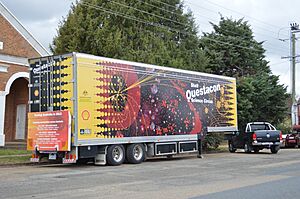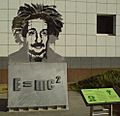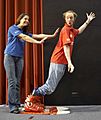Questacon facts for kids
 |
|
 |
|
| Established | 1986 (opened in 1988) |
|---|---|
| Location | Parkes, Australian Capital Territory, Australia |
| Type | Science Centre |
| Accreditation | Asia Pacific Network of Science & Technology Centres (ASPAC) |
| Visitors | 500,000 per year since 2016 |
Questacon, also known as The National Science and Technology Centre, is an exciting place in Canberra, Australia. It is a science museum filled with over 200 hands-on exhibits. These exhibits help you learn about science and technology in a fun way.
Many schools from all over Australia visit Questacon for special trips. The centre also has a program called the Questacon Science Circus. This program takes science fun to people in different parts of the country.
Contents
Discovering Questacon's History
Questacon started as a small project at the Australian National University (ANU). It began in some extra rooms at Ainslie Public School in Canberra. It first opened with only 15 exhibits.
Professor Mike Gore AM, a physics lecturer from ANU, helped run it with volunteers. He was inspired by the Exploratorium in San Francisco, which is another interactive science centre. Professor Gore wanted to create something similar in Australia.
The name 'Questacon' combines two words: 'quest,' meaning to discover, and 'con,' meaning to study. Professor Gore became Questacon's first Director. He received an Australia Day honour in 2015 for his important work in science.
The Current Building and Its Opening
The building Questacon is in today was a gift from Japan to Australia. It was given for Australia's 1988 Bicentenary celebrations. The centre officially opened on November 23, 1988.
The Japanese government and businesses gave a lot of money, about half of the total cost, to help build it. Before this, Questacon was in the Ainslie Primary School building.
Who Leads Questacon Now?
The current director of Questacon is Jo White. She started her role in November 2022. Before this, she worked at the Royal Botanic Gardens in Sydney. The previous director, Professor Graham Durant AM, retired in August 2021 after leading Questacon for 19 years.
Exploring the Galleries
As of 2025, Questacon has eight main galleries for you to explore. Each gallery focuses on different areas of science and technology.
- ZAP! CLANK! POW! This gallery is all about magnets, machines, electricity, and how things move.
- Fundamentals Here, you can find classic science exhibits that show basic scientific ideas.
- Awesome Earth Learn about natural disasters and how our planet works. You can even see a Tesla coil and try an earthquake simulator!
- The Q Lab This is a special space for experiments. It also has the Questacon Beehive exhibit, where you can see real bees.
- The Shed In this area, you can experiment with different ideas, tools, science, technology, and even art.
- MiniQ This gallery is made just for younger children, from babies up to six years old. It has a water play area, a building zone, and a quiet space.
- Excite@Q This gallery shows amazing science phenomena. It includes activities like BATAK and the thrilling Freefall slide.
- Mangroves – Tales from the Tide This display teaches you about the mangroves found in the Top End of the Northern Territory.
Besides the main galleries, there are other cool exhibits:
- The Foyer When you enter, you'll see a Robot, the Clockwork Universe, and the Cam Wave. There's also the Questacon Shop here.
- The Moon Gallery This is a quieter space with interactive displays about the moon. It's a good place to relax.
- The Science Garden This is an outdoor area with different exhibits. It includes the NKRYPT exhibit, which was put there in 2013 to celebrate Canberra's 100th birthday.
Questacon welcomes about 500,000 visitors every year. Around 200 paid staff and about 80 volunteers help run the galleries and programs.
Science Theatre Shows
Questacon has special areas where performers put on shows for visitors and students. These performers are part of Questacon's own theatre group, called the "Excited Particles." They also do fun puppet shows for younger kids.
The NKRYPT Outdoor Exhibit
NKRYPT is a unique sculpture outside the Questacon building. It has eight stainless steel poles with secret messages carved into them using lasers. This outdoor exhibit was added in 2013 during the Centenary of Canberra. A prize was even offered to the first person who could solve one of the puzzles!
Questacon Technology Learning Centre
The Questacon Technology Learning Centre is located in Deakin. It is in the building that used to be the administration office for the Royal Australian Mint. More than 80 staff members work here.
This is where all the outreach programs and exhibition ideas are developed. Researchers, designers, and staff who work with electronics, metal, and wood are based here. The centre also has an exhibition area and spaces for technology workshops and holiday programs.
Amazing Outreach Programs
Questacon doesn't just have exhibits in Canberra. It also runs programs that travel around Australia. The Questacon Science Circus and Engineering is Elementary are national programs. Q2U is a program that visits places in the Canberra region.
Some past programs included the Tenix Questacon Maths Squad and NRMA Roadzone. Questacon has also run programs in remote Indigenous communities.
The Questacon Science Circus

The Questacon Science Circus is a very popular program that takes science fun to many places. It is one of the biggest science outreach programs of its kind. Every year, the Science Circus reaches over 100,000 people. It travels about 25,000 kilometres across Australia.
The circus also helps teachers by running workshops to improve their science teaching skills. It visits about 30 remote Indigenous communities, as well as hospitals, nursing homes, and special schools.
The Questacon Science Circus is a partnership between Questacon and the Australian National University. In 2006, the Science Circus won the Prime Minister's Award for Community Business Partnerships.
Fifteen or sixteen science graduates work for the Science Circus as it travels. They bring exciting science presentations to towns and schools. While working for the Science Circus, each presenter also studies for a Masters of Science Communication Outreach degree. This degree is from the Centre for the Public Awareness of Science at the Australian National University. Their studies include learning about print media, how to evaluate programs, and how to design exhibitions.
Every year, a new team of presenters is chosen for the Science Circus. The first team graduated in 1988. Now, there are over 300 Science Circus graduates. These graduates have gone on to work in many areas of science communication. Some have contributed to programs on Australian Broadcasting Corporation Radio and podcasts like The Mr. Science Show.
Images for kids
See also
- Inspiring Australia
- List of science centers









